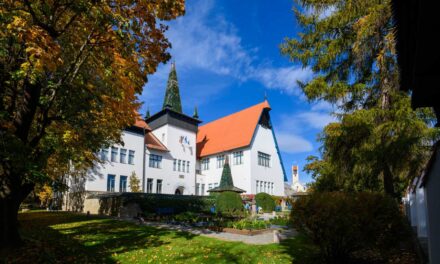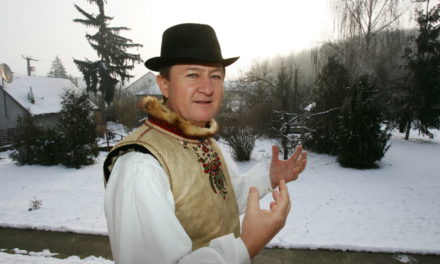The Romanian tricolor memory policy is just that.
Even today, the Hungarian soldiers who were buried after the bloody events of the Battle of Torda 80 years ago are still considered enemies. While the remains of the Hungarian national guards exhumed from the Jewish cemetery in Cluj-Napoca in 2015 have been waiting for reburial in the corner of a village chapel for 9 years, the graves of Hungarian soldiers in Cluj-Napoca were filled with the Romanian tricolor this summer and have only just been removed. Krónika explored the attitude of the insensitive Romanian authorities with the historian Kristóf János Murádin.
Hungarian soldiers' graves in the Házsongárd cemetery were covered with ribbons of the Romanian national color on June 13 this year, on Heroes' Day, under the supervision of the 4th Transylvanian Infantry Division of the Romanian army, as the Cluj-Napoca division is responsible for the care of military cemeteries in the area. The cadets of the Septimiu Mureşan Police Training School placed flowers, candles and tricolors on the concrete crosses of the national defenders. The Hungarian portal Hvg.hu first drew attention to the "decoration" of the Romanian, Hungarian and German soldiers' graves with the Romanian tricolor, calling the gesture a "political grave robbery".
Not by chance, because the Romanian way of paying respects, which is contrary to the international practice of caring for war graves, can be considered a violation of grace, since these patriots fought against the Romanian troops during the World War II.
The Hungarian authorities and institutions did not take a stand on what happened, probably out of consideration to avoid creating another nerve point in the already strained Romanian-Hungarian relationship. The Hungarian Ministry of Defense (HM) answered Hvg.hu's question:
although he is informally aware of the incident, the Romanian side did not officially notify him of the placing of ribbons in Romanian national colors.
The ribbons of the Romanian national color that were attached to the concrete stone crosses more than three months ago have recently been removed from the stone crosses; it is not known who, but it is most likely that the authorities of the Romanian army acted again, admitting their mistake. It should be noted that no tricolor was placed on the heads of the Soviet soldiers at the memorial site created for the soldiers of the First and Second World Wars at the southeast end of the treasured city cemetery.
About a hundred Hungarian soldiers buried in the Házsongárd in Cluj were wounded in the battles around Torda just 80 years ago. The retreating Hungarian army transported them to the military hospital in Cluj, where they died. The Battle of Torda took place between September 15 and October 7, 1944. In the battle, the Hungarian-German units held off the attacking Romanian and Soviet forces for three weeks, preventing them from breaking into North Transylvania, which was annexed to the Kingdom of Hungary based on the Second Vienna Decision.
Historian Dr. János Kristóf Murádin, associate professor, head of department at the Sapientia Transylvanian Hungarian University, told Krónika:
it is short-sightedness on the part of the Romanian authorities to tie the graves of the Hungarian national defenders with ribbons of the Romanian national color. They don't want or can't make themselves aware that the tortured land of Transylvania is soaked with the blood of not only Romanian but also Hungarian soldiers. In Romania, this is a symbolic attempt to seize space, which can be felt in everything from churches to war graves
– the Cluj historian pointed out the background of what happened. According to Murádin, "bragging" with the Romanian tricolor on Hungarian war graves shows absurd insensitivity, which is both dangerous and bad, because it shows how much we are valued by those for whom Hungarianness is an abstract concept.
Make-believe solutions inherited from communism
The roots of the story go back much earlier. The Soviet era played a big role in the fact that the graves of Hungarian soldiers were able to remain in the Házsongárd cemetery at all. The Soviet leadership of the time stipulated that no distinction should be made between deceased soldiers in accordance with the ideological framework, and that everyone's graves should be preserved - this apparent reconciliation was shown in the preservation of Hungarian war graves in some Transylvanian cemeteries.
According to Kristóf János Murádin, it is thanks to the Soviet era that the Hungarian soldiers' graves were able to remain in the Cluj-Napoca cemetery. "We are only talking about an outward-looking solution, since during the communist period in Romania there was no question of commemorating the fallen Hungarian soldiers," the historian, who also deals with military history research, revives the course of the communist past. In the past 80 years, the Romanian authorities have never dealt with the pardon and other expectations related to the Hungarian war graves.
"There was a lack of research on who rests in the graves, there was no professional excavation, and there was no registration of the graves. This is also the cause of the trouble in the Úzvölgy military cemetery"
- points out the specialist.
The attitude of the Romanian officials did not change significantly even after 1990. An international war grave care agreement was signed between Romania and Hungary, but the Romanian side handles this very lightly. With the dissolution of the Soviet Union, the Soviet regulations regarding war graves disappeared in the former vassal states, and from the nineties, Hungarian war graves also fell into the tolerated category in Romania. Actually, there is no honest opening in the direction that there was a war conflict here, and the dead soldier is not an enemy.
"It doesn't matter what nationality he is, the deceased soldier is a hero who deserves respect. There is a lack of uniform tributes to deceased soldiers in Romania. As we move forward in time, and the Hungarian minority recedes into the background, this phenomenon becomes more and more evident"
- emphasized the university lecturer from Cluj.
The promised but forgotten Hungarian military cemetery
The Romanian-Hungarian intergovernmental agreement on the care of war graves could be an important legal framework if the Romanian side followed it, on the other hand, we find that it is actually only important for the Hungarian side, Murádin points out. There are also Romanian war graves in Hungary at the sites of the Armored Battle of the Great Plain, and in Budapest due to the siege of the Hungarian capital, which are cared for by the Hungarian authorities. In contrast, the Romanian side's attitude towards the remains of 90 Hungarian soldiers exhumed in the Jewish cemetery in Cluj-Napoca in 2015 is telling. At that time, Bucharest promised that a central Hungarian cemetery could be established in Maros County, in the Mezőpanit area, but the exhumed human remains are still waiting for reburial in a corner of the Mezőség village mortuary after nine years.
According to the historian, the central Hungarian war cemetery should have been completed in 2016, but the promise from the Romanian side died, and since then there has been no initiative in the matter.
"It's an unfair story to the fallen veterans who were buried in small cardboard boxes in a corner of the funeral home. This could not have happened with Romanian soldiers"
- the historian draws attention to the scandalous behavior of the Romanian authorities.
Traditionalists left to themselves
The care of the existing Hungarian war graves fell into good hands after December 1989, when it was possible to speak and hold memorials about the Hungarian soldiers who died in Transylvania. Civil initiatives started immediately, and with this a new era began in the exploration of Hungarian-related war events, which had been a taboo subject for more than four decades.
József Pataki, from the Castle Village in Aranyoszék to the Wailing Wall in Nagyenyed, searched through all the graves of Hungarian soldiers that could be found, and erected 42 monuments and memorial signs. Among them are memorial plaques, headstones, actual monuments, marble plaques, or even graveyards, such as those in Torda or Nagyenyed. He started a process that the Torda Tradition Preservation Committee will continue"
- praises the work of the traditionalist from Torda, who died a few years ago, according to the historian, who says that thanks to the civilians, a bottom-up culture of commemoration has developed throughout Transylvania, from the northern tip of Partium through Bánság to Székelyföld.
János Kristóf Murádin considers it regrettable that the civilians who take on the burden of caring for war graves receive minimal support from the Hungarian side and no support from the Romanian side.
"Politics is less and less receptive to what happened 80 years ago. Strong Hungarian support and the construction of a large Hungarian military cemetery could even lead to a conflict with the Romanian side. The more convenient solution for the Hungarian side is to support local civil initiatives with small change - let the traditionalists solve the issue of the soldiers' graves on their own - which does not bother the Romanian side"
- explains the specialist.
Italian-Hungarian reconciliation could be the model, according to Murádin, the fact that the Romanian Army Day is October 25, when they "liberated" the last territories of Transylvania - Nagykároly and Szatmár - from the "Horthysta-fascist rule" is telling. All of this clearly shows the spirit that defines the Romanian attitude towards Hungarian war graves. It is much more comfortable to nestle into this nationalist situation, which the Romanian majority celebrates with applause and is happy, than to make a gesture in the direction of Hungarians to clarify the past with a kind of Western mentality.
János Kristóf Murádin highlights the Italian-Hungarian reconciliation as a positive example. The two countries are I. and II. they also faced each other in World War II, at least after the Italian transition in 1943. Quote Today in Northern Italy, the Italian and Hungarian graves of soldiers lying next to each other are equally respected, and the Hungarian chapel in the Dolomites helps the Hungarian commemorators who come here, who cover the graves of Hungarian soldiers with red, white and green ribbons of the national colors.
One can imagine what would happen if the graves of the Házsongárd cemetery were similarly surrounded with ribbons of the Hungarian national color
- concludes historian János Kristóf Murádin, head teacher at Sapientia University.
Featured image: A stone cross marks the grave of a veteran who died a heroic death in the Battle of Torda Photo: Levente Oláh-Badi / Krónika













